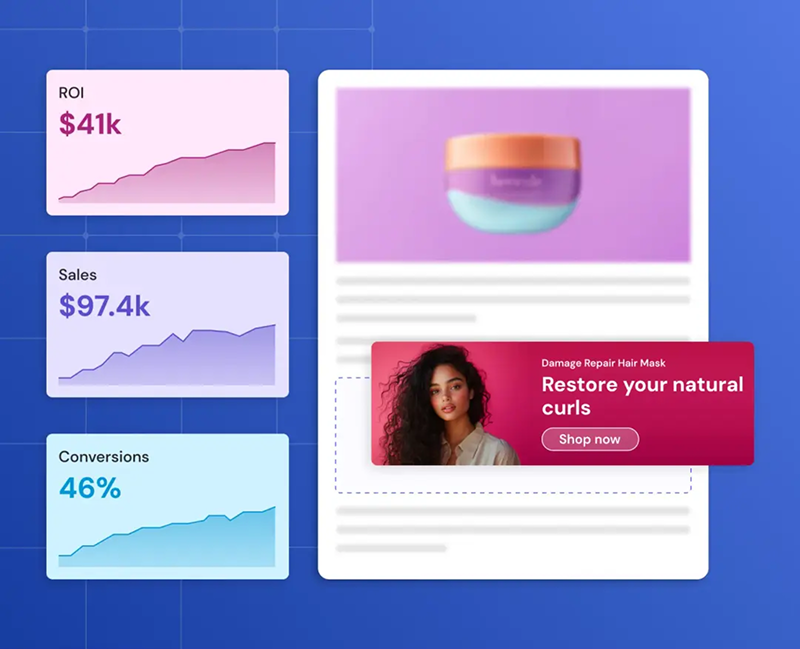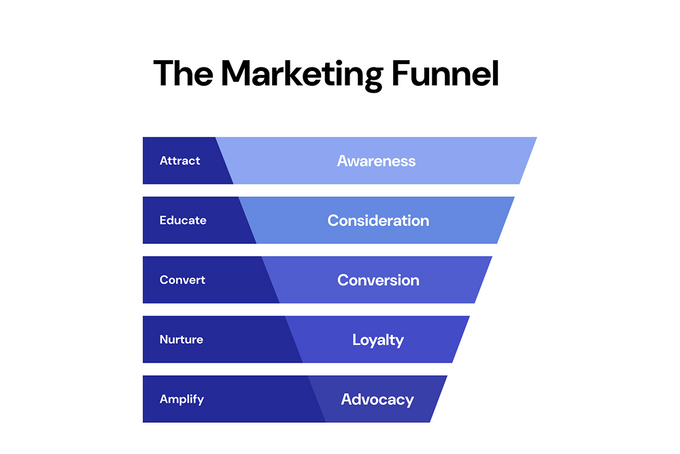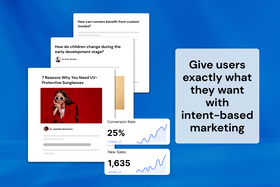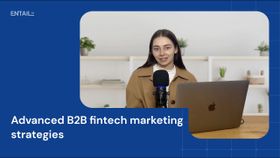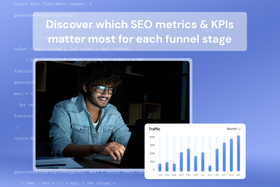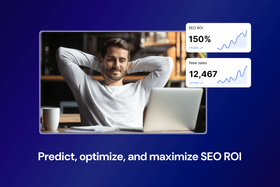The 5 stages of the marketing funnel explained
Get a full breakdown of the five stages of the marketing funnel and discover strategies to optimize each.
Updated February 21, 2025

Understanding the various marketing funnel stages is key to guiding potential customers from discovery to purchase and beyond. Each stage—awareness, consideration, conversion, loyalty, and advocacy—plays a role in attracting, engaging, and retaining customers.
By mapping and optimizing this journey, you can create targeted strategies that increase conversions, build long-term relationships, and drive growth. Here's a breakdown of each stage and how to optimize it.
Key takeaways
- A marketing funnel maps the user journey, from first discovering your brand to converting and becoming an advocate.
- Marketing funnels help businesses attract, engage, and convert potential customers while identifying friction points.
- Depending on the specific model you use, marketing funnel stages can be broken down into awareness, consideration, conversion, loyalty, and advocacy.
What is a marketing funnel?
A marketing funnel is a visual representation of the stages potential customers go through before making a purchase—from the moment they first learn about your brand to the point where they become loyal, repeat customers.
The marketing funnel starts wide with more potential leads at the top and narrows toward the bottom as people drop off at different stages. Not every lead converts, but the most qualified ones usually reach the bottom of the funnel and become customers.
The purpose of a marketing funnel is to map out key milestones in the user journey, see where users drop off, and optimize those touchpoints. By visualizing the process as a funnel, marketing teams can create targeted content and strategies that attract, engage, and convert prospects more effectively.
Marketing funnel vs. sales funnel
It's easy to get the marketing funnel and sales funnel mixed up, as they're closely related and often used interchangeably. However, they serve slightly different purposes:
- Marketing funnel: Focuses on attracting and engaging potential customers, generating new leads, and building brand awareness. It gets people in the door.
- Sales funnel: Focuses on nurturing and converting those leads into paying customers. It closes the deal.
The marketing funnel feeds into the sales funnel. Think about it like this: once your marketing efforts generate leads, they're passed to the sales team to nurture and convert.
» Discover tried-and-tested SEO lead generation techniques.
The importance of marketing funnels
Marketing funnels help businesses understand and optimize the user journey, which is especially important since most journeys today aren't linear. By mapping out each stage, it becomes easier to track where users drop off, identify friction points, and improve conversion rates.
These funnels also guide marketing strategies by showing what content and tactics work best at each stage. They help teams measure the effectiveness of their campaigns, refine their approach, and get better results. Marketing funnels also support customer retention by helping build relationships to keep customers engaged long-term.
» Learn more about the SEO marketing funnel.
5 stages of the marketing funnel
Businesses may use different types of marketing funnels depending on their needs, such as the AIDA model or the basic TOFU-MOFU-BOFU funnel. However, for a more detailed, well-rounded view of the user journey, many businesses use a five-stage model: Awareness, consideration, conversion, loyalty, and advocacy.
Let's take a closer look at each stage.
1. Awareness
The awareness stage is at the top of the funnel. It's where potential customers first discover your brand, product, or service.
You want to stay front of mind at this stage, so your goals will include:
- Building brand recognition and familiarity to ensure your target audience knows your brand exists.
- Helping potential customers understand they have a need or problem that your product or service can solve.
- Sparking curiosity and making people want to learn more about what you offer.
- Getting your message in front of as many relevant people as possible.
Marketing strategies for the awareness stage
To optimize the awareness stage of the marketing funnel, businesses can use the following marketing strategies:
- Run advertising and social media campaigns to reach a wider audience.
- Use referral programs to encourage word-of-mouth marketing.
- Invest in SEO to improve visibility in search results.
- Create top-of-the-funnel content like blog posts, videos, and guides.
The key is to focus on being helpful, informative, and engaging—selling comes later.
» Find out how to create a high-converting content strategy.
2. Consideration
In the consideration stage, potential customers are evaluating different options to see which best meets their needs. They're comparing features, pricing, and benefits—but they haven't made a decision yet.
While they're more likely to buy than in the awareness stage, your brand still isn't their first choice. So, the goal here is to build trust, educate and inform users, and position your brand as the best solution.
Marketing strategies for the consideration stage
Examples of middle-of-the-funnel marketing strategies that guide users to the next funnel stage include:
- Share customer reviews and testimonials to build trust.
- Offer white papers, e-books, and other lead magnets.
- Showcase case studies to demonstrate real-world success.
- Provide product guides, demos, and comparisons.
- Use email marketing to nurture leads with relevant content.
READ MORE: How to create content that converts
3. Conversion
Also known as the "decision" or "action" stage, the conversion stage is where potential customers decide to take a desired action—whether that's a purchase, a subscription, a sign-up, or any other action that signifies a prospect becoming a customer.
Success at this stage depends on the trust and engagement built in the earlier stages. It's essentially the culmination of all your marketing efforts up to this point.
At this stage, there's one primary goal: to close the deal.
» Build a conversion funnel to close more deals.
Marketing strategies for the conversion stage
To encourage potential customers to convert, you can use these bottom-of-the-funnel marketing techniques:
- Create detailed product pages.
- Use strong, clear calls to action.
- Make the checkout process as simple and intuitive as possible.
- Offer personalized discounts, promotions, or bundles.
- Provide free trials for your product/service.
- Continuously A/B test CTAs, landing pages, and checkout processes to optimize performance.
- Provide excellent customer service to address any last-minute concerns.
4. Loyalty
The loyalty stage happens after a customer makes a purchase. Its main focus is keeping them satisfied and engaged. Retaining existing customers is far more cost-effective than acquiring new ones. In fact, acquiring a new customer is five to 25 times more expensive than retaining an existing one, according to Harvard Business Review.
Fostering loyalty can help businesses stay top of mind, build long-term relationships, and encourage repeat purchases, ultimately increasing customer lifetime value (CLTV).
» Discover more essential conversion metrics to track.
Marketing strategies for the loyalty stage
Here are some effective strategies for nurturing customer loyalty:
- Implement loyalty programs to reward repeat customers.
- Send personalized emails, offers, and product recommendations based on past purchases.
- Build a community through forums or online groups to foster engagement.
- Provide exclusive content and special offers to keep customers invested in your brand.
5. Advocacy
The advocacy stage is the pinnacle of customer engagement. Here, customers go beyond loyalty—they actively promote your brand, share positive reviews, and recommend your products or services to others. At this point, they essentially become an extension of your marketing team, helping to attract new customers through word-of-mouth.
The goal at this stage is to create an environment where customers feel valued and motivated to share their experiences. A strong base of brand advocates can significantly expand your reach and drive organic growth.
Marketing strategies for the advocacy stage
While you can't force advocacy, you can nurture it. Here's how:
- Provide an exceptional customer experience.
- Actively solicit feedback and make it easy for customers to leave reviews.
- Acknowledge and appreciate brand advocates by responding to reviews, sharing their content, and featuring them in marketing materials.
- Create a referral program to reward customers for bringing in new leads.
- Host contests and giveaways that encourage customers to share their experiences with your brand.
Grow from awareness to advocacy
By understanding each stage of the marketing funnel, you can create targeted strategies that drive engagement and long-term success. That way, you can attract the right audience, guide them through their decision-making process, and turn them into loyal customers and advocates. Remember to keep refining your approach to ensure your funnel stays effective as customer behaviors evolve.
READ MORE: Content marketing funnel: Stages, content types & tips
